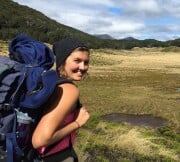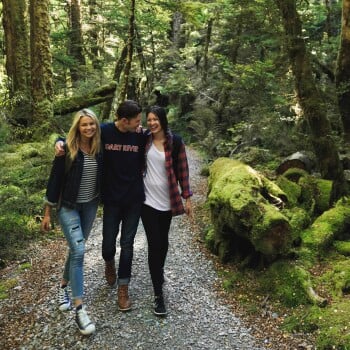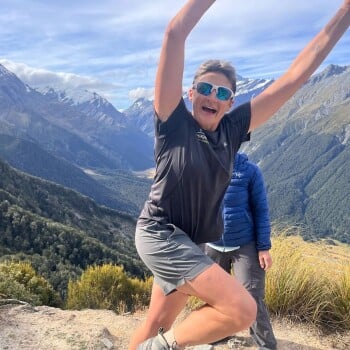- About Us
-
Trips
-
 Kiwi-Style Hiking
Kiwi-Style Hiking
-
 Great Walks
Great Walks
-
 Hiking Tours
Hiking Tours
-
Alpine Hikes
-
Custom Groups
- Huayhuash Trek
- Family Northern Explorer
- Family Southern Explorer
- Lake Waikaremoana Hike
- Women's Custom Tours
- Women's Southern Wilderness
- Coast, Canyons and Mountains
- Coastal Wanderer Custom Tour
- Don't Cross the Ladies
- Secret South Custom Tour
- Tekapo Hike
- West Coast Custom Tour
- World Heritage Custom Tour
-
- Blog
- Shortlist
- About Us
- Trips
- Blog
- Shortlist

May 8, 2024
Winter tramping is a little different, because so is winter. However, if you're adequately prepared, you have a wee bit more flexibility, and you choose a few more lowland trails, you are rewarded. Empty tracks, quiet huts and some simply stunning snowy landscapes are waiting.
By all means hike in summer (as it's nicer), however hiking in winter, it's really not such a big deal. It is still fantastic, the biggest issue is the shorter days. Take a good book or a lover for those long candlelit nights in the huts!

In fact, winter tramping conditions in many areas are not so different to summer. And arguably, in places like the far north it's more pleasant hiking in 12-15 degrees winter than the sticky, humid 25 degrees in summer .... However, the biggest surprise to many is that all our forests are evergreen, so we have lush looking forests year-round. It looks exactly the same come winter or summer.
Cape Brett area - Winter near the Bay of Island looks like this!
This is because wee New Zealand is a set of islands in the South Pacific and the weather is utterly modified by the (moderate) temperature of the oceans around it. We have neither hot summers nor cold (European style) winters. We are NOT a continental climate. It's really not that grim here, unless you go far south and climb higher. Look at our climate stats! See what I mean?
Crisp sunny days, frosted landscapes, cosy hut fires, deliciously warm hot pools, sizzling comfort food and the thrill of shared adventure are all highlights of winter hiking. You can’t experience remote and beautiful wilderness from your living room.
Here are a few of our top winter picks
National Parks / Conservation parks that offer almost all year walking:
- Anywhere north of Lake Taupō - this is a LOT of places. Cape Reinga, Cape Brett, Waipoua, Mangawhai, Whangarei Heads area, Kaimais, Coromandel.....too many others to list!
- Most trails in Tongariro National Park volcanoes area (except the mid 5 km section of the Tongariro Alpine crossing and summit areas - you may need crampons/ice axe/to be guided here)
- Low trails Egmont National Park
- All of Abel Tasman National Park
- All of Marlborough Sounds
- Most of the Paparoas
- Most of Westland National Park on The ENTIRE 600km long West Coast sits below 800-1000m (bush line), and the weather is better here in winter too. Strange but true!
National Parks /Conservation Parks that offer SOME (fantastic) opportunities just in the lower areas
- Lewis Pass
- Aoraki/Mt Cook National Park
- Mt Aspiring National Park
- Fiordland National Park

What else you might want to know
You do need to be prepared for the worst just in case. Here are some winter tramping tips.
Review your gear – make sure it’s up to the job. Take stiff boots if you are planning to kick a few steps in the snow. Ice axe and crampons are required if you're heading over passes. A full set of thermals and breathable shell outer layers are essential. For most higher (alpine) areas we’d take three warm layers plus thermals and a couple of warm hats - no cotton.
If you're just planning to tramp in Abel Tasman or do the Queen Charlotte walk, or tracks in Northland, you won't need this degree of gear. As fashionable as you feel it might be......
There are less hours of daylight – account for this when selecting your route.
Snow conditions can be different in winter – is there an avalanche risk? Seek local advice. Some avalanche chutes cross lower altitude tracks (eg. the Routeburn track and the round Mt Egmont track).
Temperatures in daytime South Island lowland areas of 8-12 degrees Celsius (maximum).
The West Coast of the South Island has great weather in winter as it’s protected from the southerlies by the Southern Alps.
Always sign in and sign out of the local Department of Conservation centre (or online) when heading out on a hike. DOC staff have an exceptional amount of experience and give balanced advice, and will take into account the amount of experience that you have.
Great Walks offer less hut facilities during the winter season. You will need a cooker and probably pots and pans. We notice that the Heaphy Track huts have plenty of pots but this is not universal. There are less likely to be any hut wardens as well. The bonus is that the huts can be cheaper in winter.
Why not give winter hiking a go?







